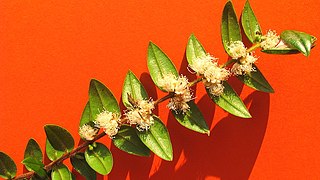
Boletus edulis is a basidiomycete fungus, and the type species of the genus Boletus. Widely distributed in the Northern Hemisphere across Europe, Asia, and North America, it does not occur naturally in the Southern Hemisphere, although it has been introduced to southern Africa, Australia, New Zealand, and Brazil. Several closely related European mushrooms formerly thought to be varieties or forms of B. edulis have been shown using molecular phylogenetic analysis to be distinct species, and others previously classed as separate species are conspecific with this species. The western North American species commonly known as the California king bolete is a large, darker-coloured variant first formally identified in 2007.

Plinia cauliflora, the Brazilian grapetree, jaboticaba or jabuticaba, is a tree in the family Myrtaceae, native to the states of Minas Gerais, Goiás and São Paulo in Brazil. Related species in the genus Myrciaria, often referred to by the same common names, are native to Brazil, Argentina, Paraguay, Peru and Bolivia. The tree is known for its purplish-black, white-pulped fruits which grow directly on the trunk; they can be eaten raw or be used to make jellies, jams, juice or wine.

Myrciaria is a genus of large shrubs and small trees described as a genus in 1856. It is native to Central and South America, Mexico, and the West Indies, with many of the species endemic to Brazil. Common names include hivapuru, sabará, and ybapuru.

Inga is a genus of small tropical, tough-leaved, nitrogen-fixing trees and shrubs, subfamily Mimosoideae. Inga's leaves are pinnate, and flowers are generally white. Many of the hundreds of species are used ornamentally.
Acioa edulis is a fruit and timber tree, which is native of Amazon Rainforest vegetation in Brazil. The trees grow naturally only within a small area of Brazil. However, they proliferate widely within this area. The tree is around 25 meters tall, and its fruits range from 8-9 centimeters in length and 4-5 centimeters in diameter.

Inga edulis, known as ice cream-bean, joaquiniquil, cuaniquil, guama or guaba, is a fruit native to South America. It is in the mimosoid tribe of the legume family Fabaceae. It is widely grown, especially by Indigenous Amazonians, for shade, food, timber, medicine, and production of the alcoholic beverage cachiri. It is popular in Peru, Ecuador, Pernambuco-Brazil, Venezuela and Colombia. The taxonomic name Inga is derived from its name with the Tupí people of South America, while the species name edulis is Latin for "edible". The common name "ice-cream bean" alludes to the sweet flavor and smooth texture of the pulp.
Edulis, edible in Latin, is a species name present in a number of Latin species names:

Hexachlamys edulis or ubajay is a species of plant in the family Myrtaceae found in Argentina, Bolivia, Brazil, Paraguay and Uruguay.
Plinia spirito-santensis, commonly known as jabuticaba peluda de cruz or Grimal in the USA, is a species of plant in the family Myrtaceae. It is endemic to broad-leafed coastal forests, at altitude, in eastern Brazil. The plant is a semideciduous shrub or small tree which can grow to between 3 and 6 metres tall. It produces edible deep reddish-purple berries, up to 30mm in diameter. At the apex of the fruit there is a small cross, from which the name derives.
Plinia phitrantha, commonly known as jaboticaba branca or ibatinga , is a species of plant in the family Myrtaceae. It is endemic to the states of São Paulo and Minas Gerais in south-eastern Brazil. The tree grows to between 2 and 7 metres tall, and produces edible fruit, between 10 and 25mm in diameter, which is green in colour due to a lack of anthocyanins in the skin.
Plinia grandifolia, commonly known as jaboticaba graúda, is a species of plant in the family Myrtaceae. It is endemic to south-eastern Brazil, and is found almost exclusively in the under-story of the Atlantic Rainforest. The tree grows to between 4 and 8 metres tall, and produces dark-purple, edible fruit, between 15 and 25mm in diameter.
Plinia peruviana, commonly known as jabuticaba cabinho in Brazil, is a species of plant in the family Myrtaceae. It is endemic to central, South America.
Plinia coronata, commonly known as jaboticaba coroada, is a species of plant in the family Myrtaceae. It is endemic to south-eastern Brazil. The tree grows to between 4 and 12 metres tall, and produces purple, edible fruit, which is between 25 and 30mm in diameter.
Plinia oblongata, commonly known as jaboticaba azeda, is a species of plant in the family Myrtaceae. It is endemic to south-eastern Brazil. The tree grows to between 4 and 6 metres tall, and produces dark-purple, acidic but edible fruit, which is between 25 and 30mm in diameter.
Plinia salticola, commonly known as dwarf mulchi or dwarf cambucá, is a species of plant in the family Myrtaceae. The tree is endemic to Costa Rica and Ecuador, grows to between 1 and 1.5 metre tall, and produces edible orange fruits.

Myrciaria strigipes, commonly known as cambucá da praia or cabeludinha da praia, is a species of plant in the family Myrtaceae. It is an evergreen shrub or small tree, endemic to Bahia and Espírito Santo in the east of Brazil. The plant grows up to between 4 and 9 metres tall, and produces edible yellowish fruits between 22 and 28mm in diameter. Consumed raw, the fruit has been described as tasting somewhere between Myrciaria glazioviana and Plinia cauliflora.
Plinia rivularis, commonly known as jaboticabarana, jabúriti, guapuriti, cambucá peixoto, jabuticaba de cacho, or piuna is a species of plant in the family Myrtaceae.
Plinia inflata, commonly known as mulchi in Ecuador or cambucá equatoriano in Brazil, is a species of plant in the family Myrtaceae. The tree is endemic to the Ecuadorian and Brazilian Amazon, grows to between 3 and 4 metres tall, and produces edible yellow-orange fruits. This plant has historically been mistaken for Eugenia subterminalis.








